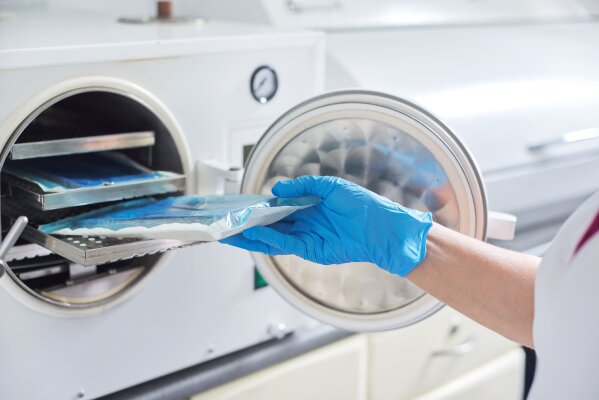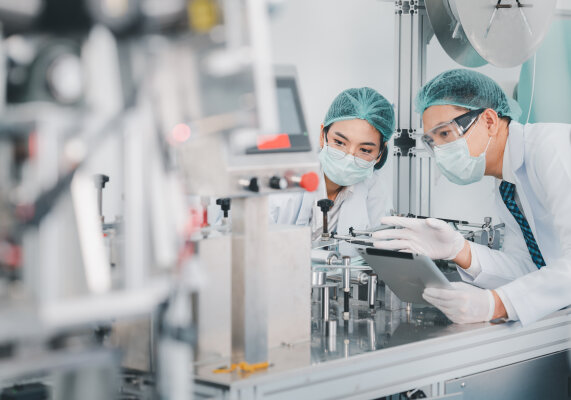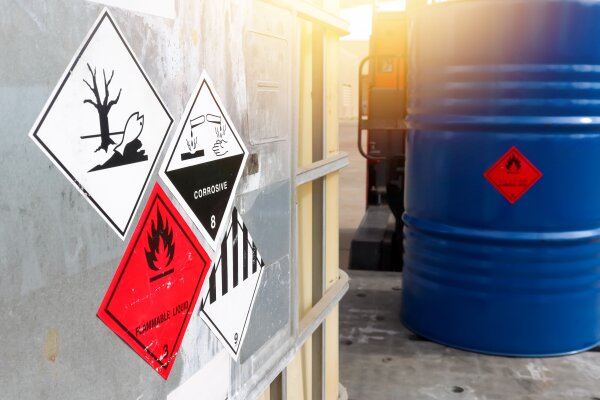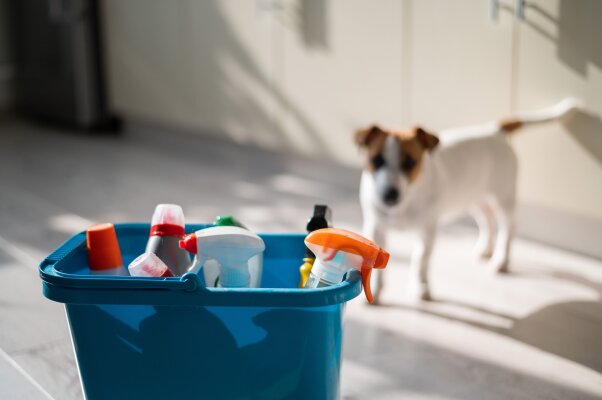What is an autoclave and how does it work? All about the topic

Autoclaves are steam sterilization devices that sterilize objects and materials using negative pressure and superheated steam. They are used in many areas and are characterized by demonstrably reproducible results. Read here about the applications for which autoclaves are worthwhile, how they work, and what needs to be taken into account when qualifying and validating the devices.
What is an autoclave? Definition and use
Autoclaving is a standardized sterilization process in which microorganisms and germs are killed and inactivated by a combination of hot steam and negative pressure. So, to the question, "What is an autoclave?" the answer can be that it includes gas-tight sealable pressure vessels used for sterilization.
In the autoclave definition, a distinction can also be made between a vacuum process and a flow or gravity process, which differ in terms of air exchange and steam inflow. However, both variants have in common that they can be used to autoclave both liquids and solids.
In addition to sterilization, these devices can also be used to cure or modify materials, provided they can generate a sufficiently high temperature and suitable pressure. This makes steam sterilizers suitable for a wide range of applications, which include the following in particular:
| Application area | Usage |
| Chemistry | Generate gas reactions under pressure |
| Medicine & Biology | Cleaning of medical instruments, dressing materials, culture media, pharmaceuticals, canned foods |
| Glass industry | Bonding of glass panes and plastic foils into bulletproof glass |
| Steam curing | Hardening of materials (such as sandstone and aerated concrete) under saturated steam atmosphere |
The autoclave: structure of the steam sterilization unit
The design of an autoclave depends largely on the purpose for which it is designed. In laboratories and medical facilities, steam autoclaves are particularly common and are available in various sizes. The interior volume can be several hundred liters, depending on needs and requirements.
Steam autoclaves are cylindrical in design and have a lid with a screw or bayonet lock. In addition, there are display elements for temperature, pressure gauge and phase progress. Steam and overpressure are introduced either as a vacuum process or as a flow or gravity process.
In contrast, autoclaves for gas and pressure reactions are equipped with stronger outer walls to withstand strong operating pressures of around 150 bar. The inner coating of Teflon prevents damage caused by high temperatures (around 650°C) and aggressive chemicals.
The autoclave: mode of operation and phases
In order for the autoclave to produce hot steam under high pressure, it is made with a special design and mode of operation. In principle, it resembles a pressure cooker (Papin's pot) in that water is brought to boiling point in a closed interior space. Then this fills with saturated steam, which cannot escape - thus a higher temperature is reached and the pressure in the steam boiler is increased.
Furthermore, the autoclave function can be divided into several processes, which are connected downstream of each other. They make up the actual operating time of the autoclave sterilization and are divided into deaeration, sterilization and drying.
Venting
Regardless of which of the main programs is executed - in a first step, the pressurized gas chamber must be completely freed of air. This enables optimum pressure conditions later on and prevents residual air islands from negatively affecting sterilization. To achieve this, the chamber of the autoclave is vacuumed several times and then filled with inflowing steam. This is why this function is also referred to as fractionated vacuuming.
Sterilization
The sterilization phase represents that process in which the actual autoclave sterilization takes place. It can be differentiated into the two sub-processes of kill time and safety margin:
- Kill time: the kill time is the period of time during which all germs, pathogens and microorganisms are killed and inactivated.
- Safety margin: In order to specifically get rid of germs with an increased resistance, the safety margin follows. This can also cushion any fluctuations in the equilibration time (i.e. the time span between reaching the sterilization temperature and reaching the required temperature for the sterilization material).
Drying
To ensure that the moisture content of the items to be sterilized does not exceed legal tolerance limits, a drying phase follows. This is also an integral part of the autoclaving phases. In this process step, a vacuum is created in the chamber, which simultaneously serves to equalize the pressure and to cool the objects or liquids.
Autoclave sterilization: program selection
Although in principle many different setting options would be conceivable, two programs have become established in autoclave sterilization. These show the best effectiveness and the highest success in various tests and examinations. In addition, there are two test programs that check, monitor and verify the autoclave function. This results in a total of four programs for most devices:
- Main program 1: In this program, the sterilization material is treated at a temperature of 121°C for 15 minutes. The absolute pressure is 2.1 bar. Some sterilizers also offer an extended program time of 20 minutes.
- Main program 2: In this program, the sterilization material is treated at a temperature of 134°C for 3 minutes. The absolute pressure is 3.04 bar. Some sterilizers also offer an extended program time of 5 minutes.
- Vacuum test program: The vacuum test is used to check whether the autoclave's pressurized steam chamber is completely tight. For this purpose, part of the air is extracted and the pressure is kept stable so that any leakage can be detected. Normally, a pressure of 1.33 bar per minute is used for this purpose.
- Bowie Dick test program: This is an air removal and steam penetration test, which can therefore also be referred to as a venting test. It is done daily before the first start-up and determines if the steam can penetrate everywhere and if all the air is exhausted.
Incidentally, in some countries, another autoclaving program is added, designed to destabilize prions. These are involved in the development of Creutzfeld-Jakob disease. The program runs through a temperature of 134°C with a sterilization time of 18 minutes.
Cooling processes after autoclave sterilization
To prevent you from burning your fingers after using the autoclave, the sterilization material must be cooled down to a safe removal temperature in the device. With liquids in particular, there is also a risk, in combination with the overpressure, that the sterile goods will simply boil over after the lid is opened. For this reason, autoclaving devices are equipped with cooling, whereby a differentiation can be made between different variants:
Cooling with support pressure
Autoclaves with this function feature cooling by radiation. In this process, the pressure vessel is cooled down with cold water over the entire surface by external cooling areas. This rapid recooling with support pressure allows increased productivity gains, as process times can be significantly reduced. The sterile goods do not come into contact with water during this autoclave sterilization.
Cooling by steam release
This is contrasted with cooling by evaporation, which works in the sense of self-cooling by a slow release of steam. Usually, a fan is installed in the autoclave for this purpose, which blows the cool room air from outside to the pressure vessel. This variant does not require support pressure, but it also has disadvantages. For example, the risk of boiling or even boiling over increases with liquid sterilization material.
Autoclave qualification
For autoclave sterilization, it is necessary that the device can perform effective and reproducible sterilization processes. For corresponding proof, the so-called qualification is carried out. It consists of four steps and must be carried out before the autoclave is put into operation for the first time.
- DQ - Design Qualification: In this process, it is checked whether the autoclave complies with the quality-relevant requirements and whether the specifications regarding its components, equipment and auxiliary devices have been met by the manufacturer.
- IQ - Installation Qualification: In this step, compliance with all set and legally prescribed requirements is then checked. This includes, for example, technical specifications and documentation.
- OQ - Operational Qualification: This involves verification of the limit values: Only if these autoclave functions are complied with is the device suitable for the intended work area and can demonstrate that it functions as planned. Therefore, calibration is also included in the OQ.
- PQ - Performance Qualification: Finally, in this performance verification, the specifications are directly compared to the actual performance. Only then can a documented proof be issued.
- Closure: Closure is the last step in which the qualification of the autoclave is completed and an interval for the first re-validation is defined.
What is the validation at the autoclave?
However, autoclaving equipment must not only be qualified prior to commissioning, but must also be subjected to validation at regular intervals. This is required by law and standardized in accordance with DIN EN 554. It must be performed at least annually. The following steps are necessary for the validation of autoclaves:
- Commissioning: In this step, it is checked whether the autoclave complies with all described manufacturer specifications and can be identified accordingly. This includes, for example, technical, organizational and operational preconditions and all specifications.
- Performance assessment: Then it is checked whether the set sterilization conditions are maintained during each sterilization process and whether the qualitatively same result is obtained with each loading. For this purpose, the device is tested under different loads and configurations.
- Re-commissioning: The execution of a re-commissioning is exactly the same as the commissioning, but the timing is different. For example, a re-commission becomes necessary whenever the equipment or technology of the autoclave has been changed, or when deviations from previous validation data suddenly appear.
- Re-performance assessment: Re-performance assessment is also the same as the initial method of performance and is due at a regular interval. This ensures that the performance of the device does not degrade over time. A maximum of one year is prescribed as the legal interval.
What is an autoclave for the laboratory? An indispensable sterilization device
What is an autoclave? These special sterilization devices work with steam and overpressure to render microorganisms harmless. Autoclaves are characterized by reproducible sterilization results and a wide range of possible applications - not least because of this, they are part of the basic equipment in laboratories, medical facilities and many technical industries.
Do you have questions about the topic or would you like to suggest a topic? Feel free to contact us by phone at +49 30 2096579 00 or send us an email at info@medsolut.com.




